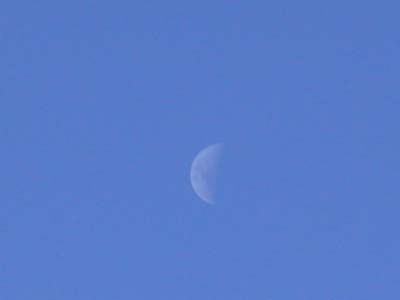TIGER Questions and Answers
about Antarctic Climate
Dr. Eric Christian of NASA GSFC was in Antarctica for the launch of the balloon-borne instrument, TIGER. He answered questions about Antarctica and the mission while there and since.
- Can you see the moon all day or not at all?
 You can see the moon only during half the month, and it is the half when the moon is a crescent. The closer to a quarter moon it is, the closer to the horizon it is. During a full moon, the moon is on the opposite side of the Earth from the Sun, and now the south pole is tilted towards the Sun and away from the Moon. But to prove it is visible, I took this picture from out on the ice shelf.
You can see the moon only during half the month, and it is the half when the moon is a crescent. The closer to a quarter moon it is, the closer to the horizon it is. During a full moon, the moon is on the opposite side of the Earth from the Sun, and now the south pole is tilted towards the Sun and away from the Moon. But to prove it is visible, I took this picture from out on the ice shelf.
- We notice the daily range of temperatures is only about 10 degrees. Do you even feel the temperature change from low to high?
I haven't really noticed it, but it is evident. During the day, on nice days, puddles of mud can accumulate in McMurdo (the "polies", those who work at the pole, call it McMuddo). In the morning, they're all frozen. Personally I notice the wind a lot more than the actual temperature.
- Is the snow "packing" snow or fluffy snow?
The snow is rather curious, dry, crystalline snow. It doesn't pack into snowballs the way wetter snow would, but in places where time and pressure have packed the snow, it is almost like styrofoam in consistency. The other incredible thing about it is how sparkling it is. The crystals catch the bright sunlight, and it looks as if someone mixed glitter into the snow (OK, who ordered 100 million tons of glitter?). I haven't been able to capture that effect in photos.
- What are storms like there? How are they different from the U.S.? How cold is cold there? Our models show the atmosphere is lower there - can you detect this just watching the clouds, etc?
The weather has been mostly clear. When it's not clear, there are either fluffy (frequently lenticular or lens-shaped) clouds, or a low overcast where you can't tell cloud shape. [As of December 7th] I haven't seen any storms yet. I'd like to see one "Herbie", short for Hurricane-Blizzard, which they can get any time of year here. [Eric did get to see a Herbie on December 18.] The cold only seems to be a problem when the wind blows, and it hasn't been really, really cold since I got here. I haven't noticed the lower atmosphere, but up in northern Canada I most noticed it with storms, and I haven't seen a storm yet.
- Does the snow taste different there because there is no pollution?
The snow doesn't taste any different, but it is gritty, because it's very dry and crystaline.
- What is the average temperature in Antarctica? the high? the low?
It varies quite a bit over the continent. And the pole is not the coldest point on Earth. The Russians have a base (Vostok) on the high plateau that averages colder than the pole, and also has the coldest recorded temperature (I think it was -93 F). An encyclopedia or book on Antarctica can probably give you better numbers than I can.
- How much do you have to plan for a changing temperature?
Layering is the name of the game. The big problem is that they keep the buildings quite warm (although that really isn't a problem). Many people just move quickly from building to building without putting on all their gear (I've seen shorts outside). But outside, if you're working hard, it requires taking off a few layers to keep from sweating too much. Sweat will cause you to get very cold when you stop working. I've covered clothing in one of my special reports.
- How easily does your body become acclimated to this climate?
I haven't had any problem yet. We'll see after "Happy Camper School", when I have to spend a night out on the ice. [You can see how Happy Camper School went on November 13 and November 14.]
- When you first arrive, how does your body react to the shock?
The full ECW (Extreme Cold Weather) clothing did it's job, and I didn't have any problem.
This page was last modified on October 27,
2003
|
|
|